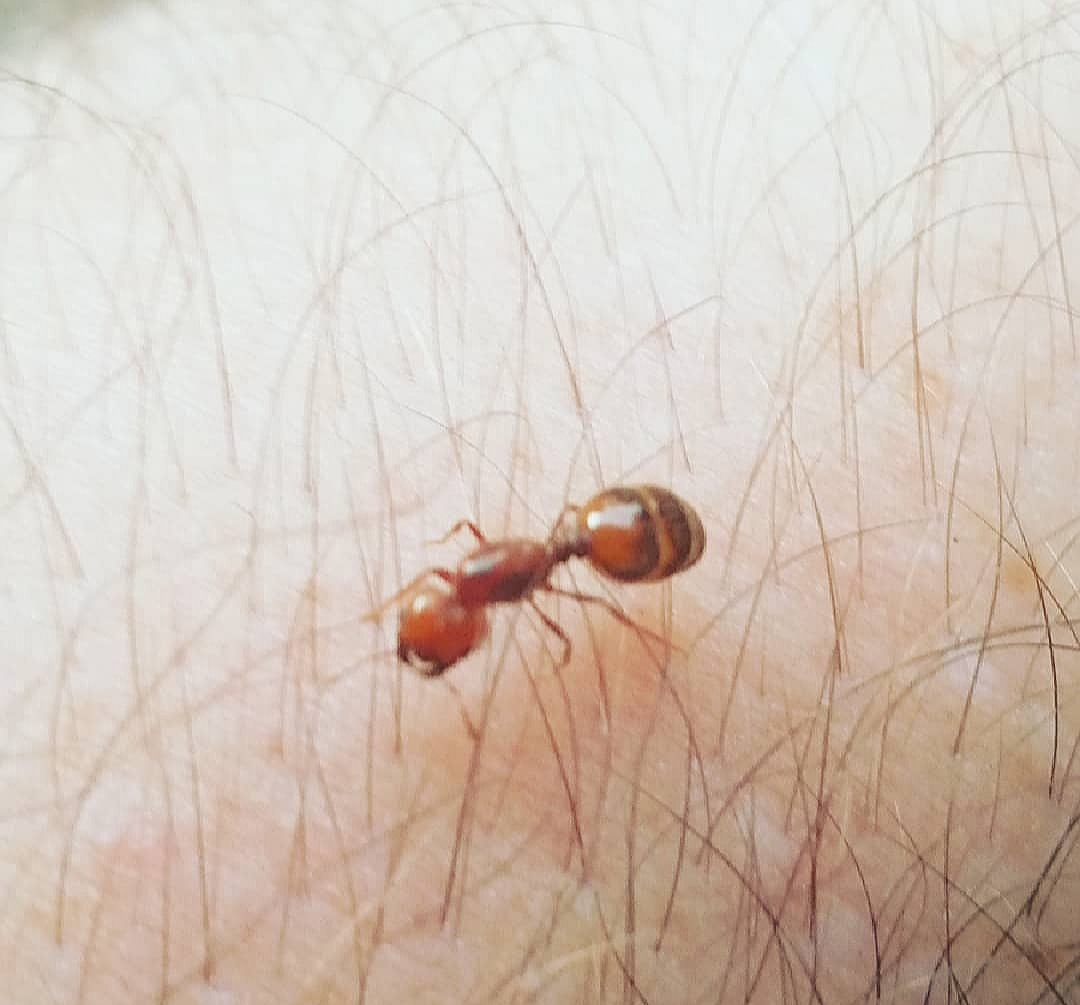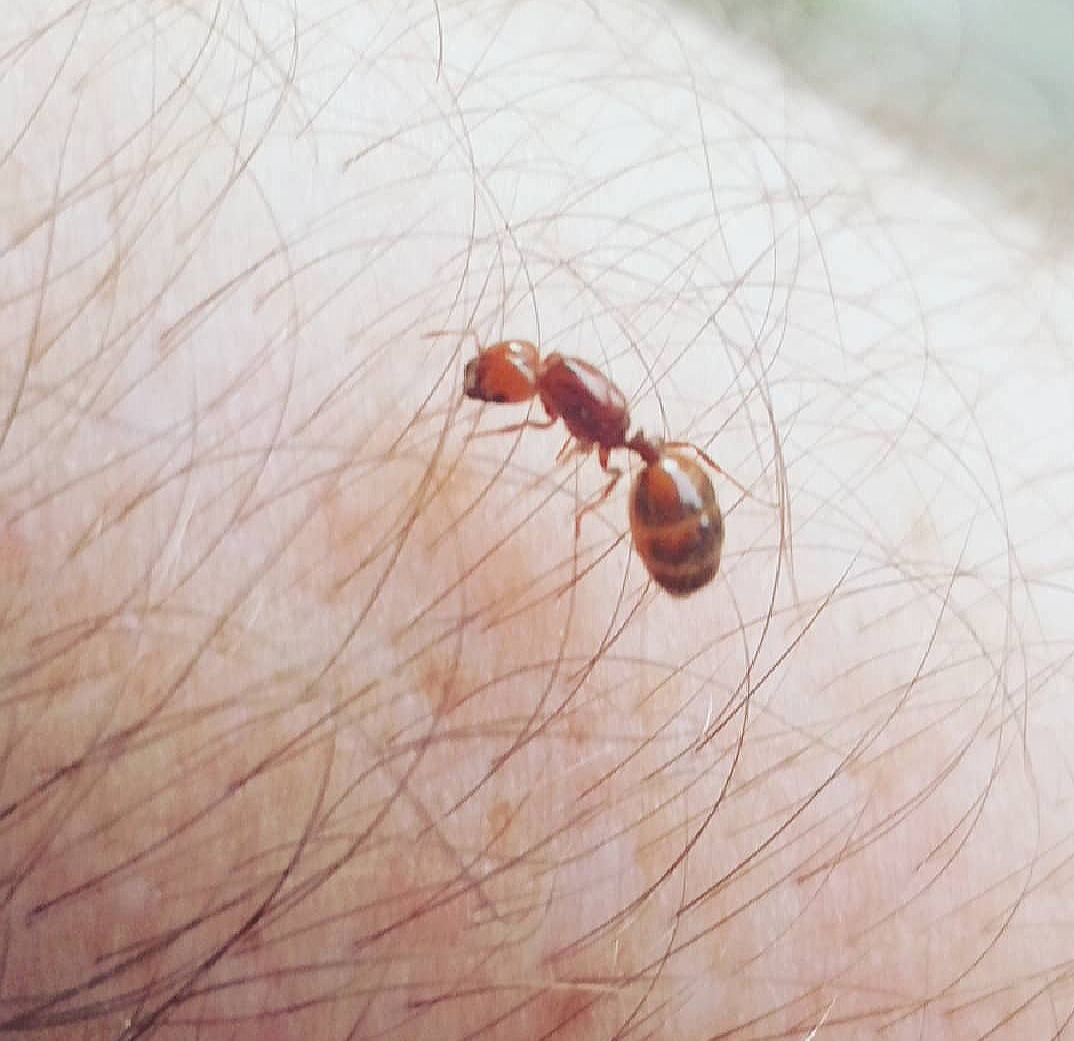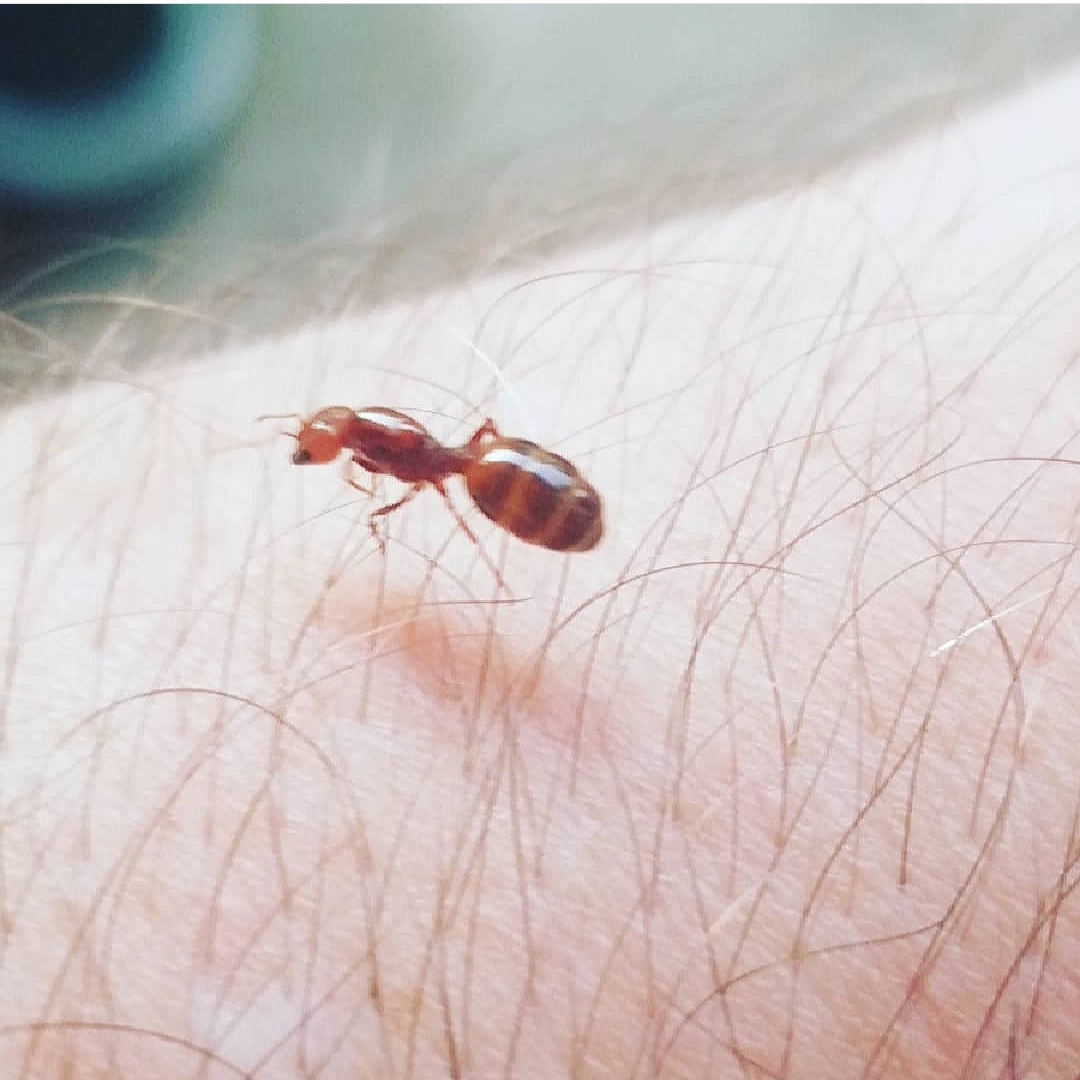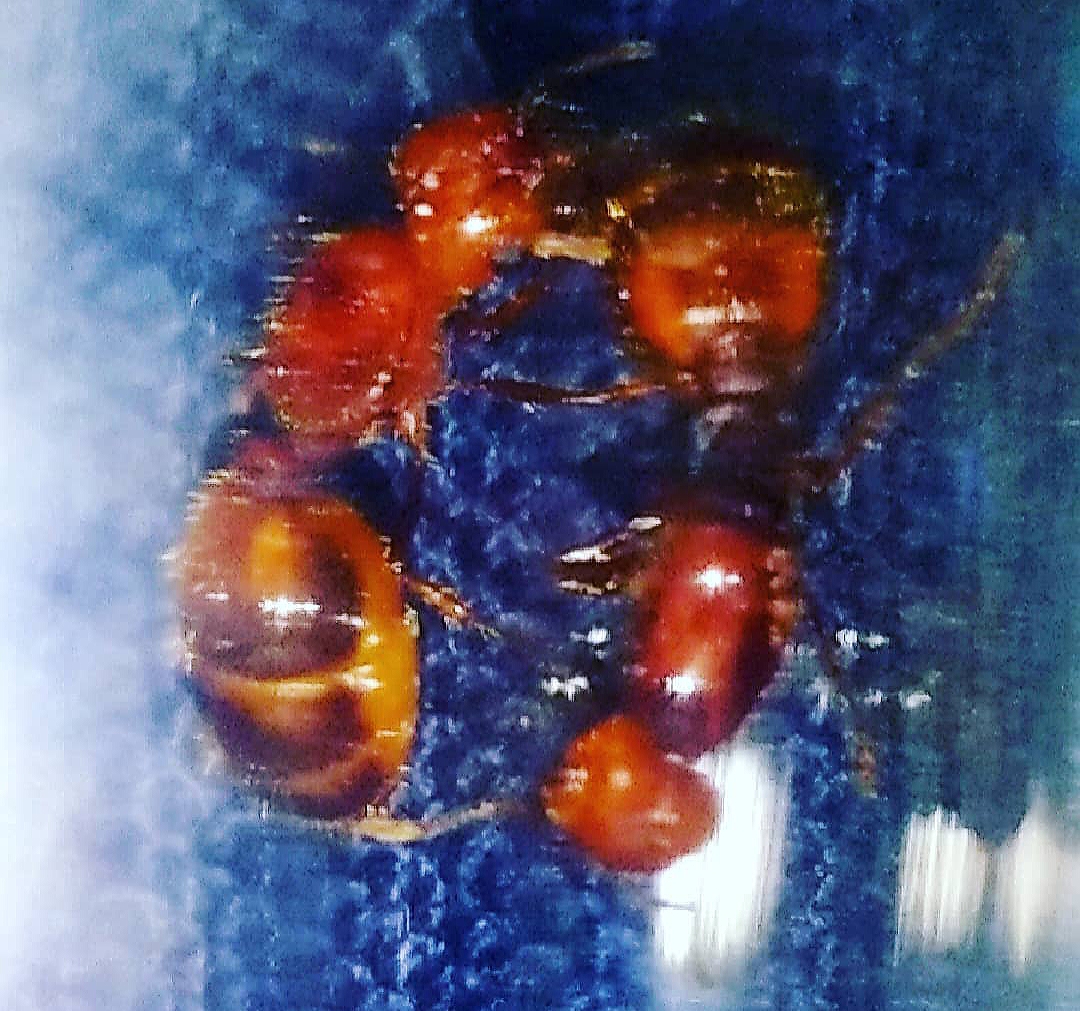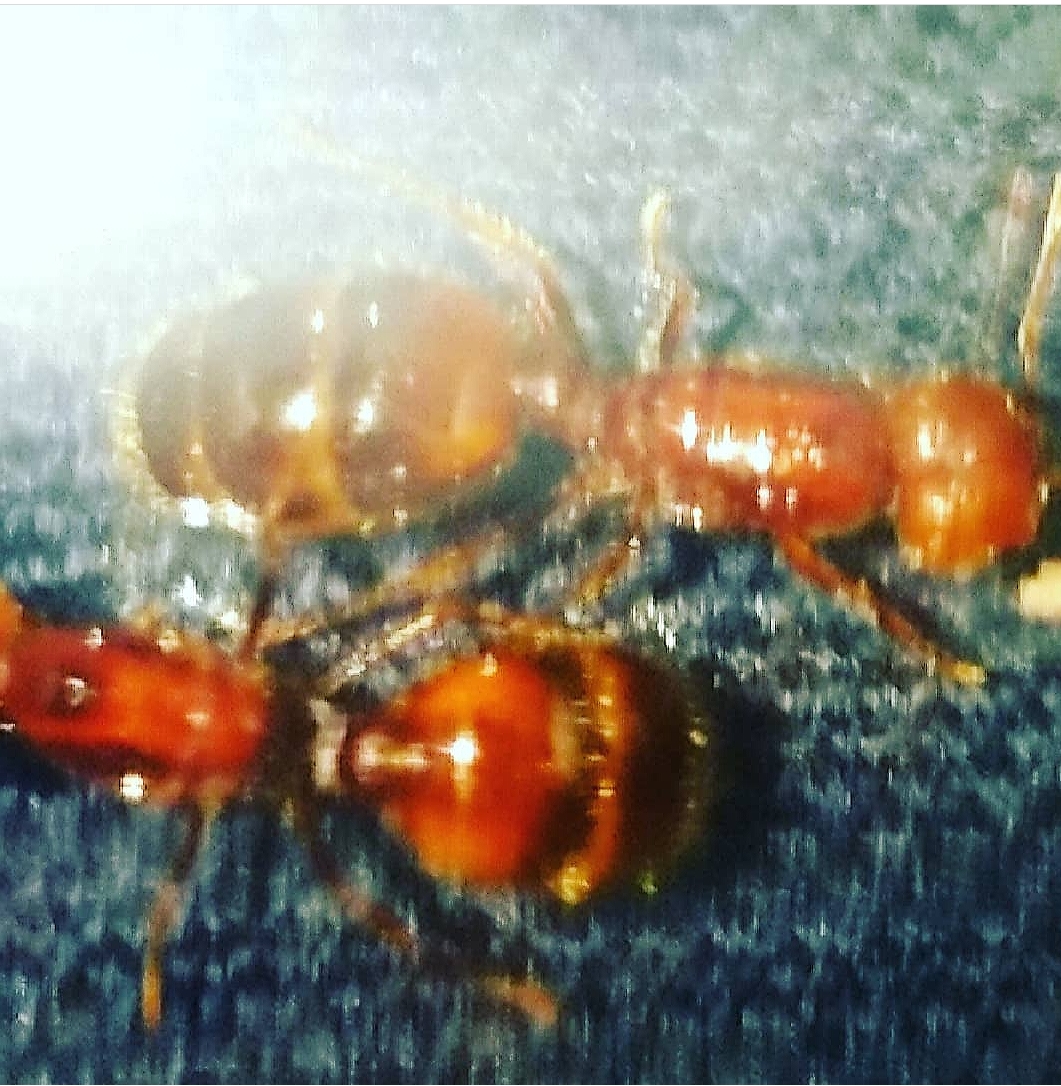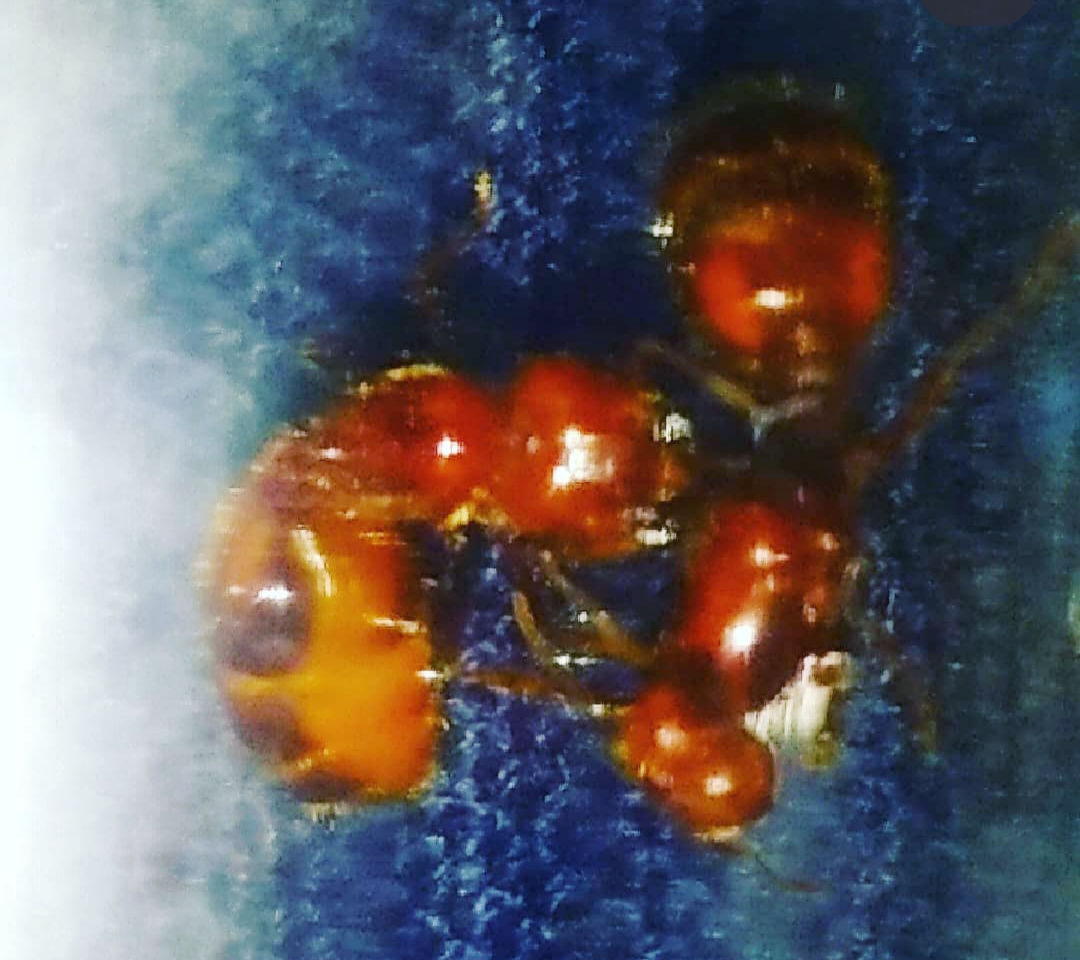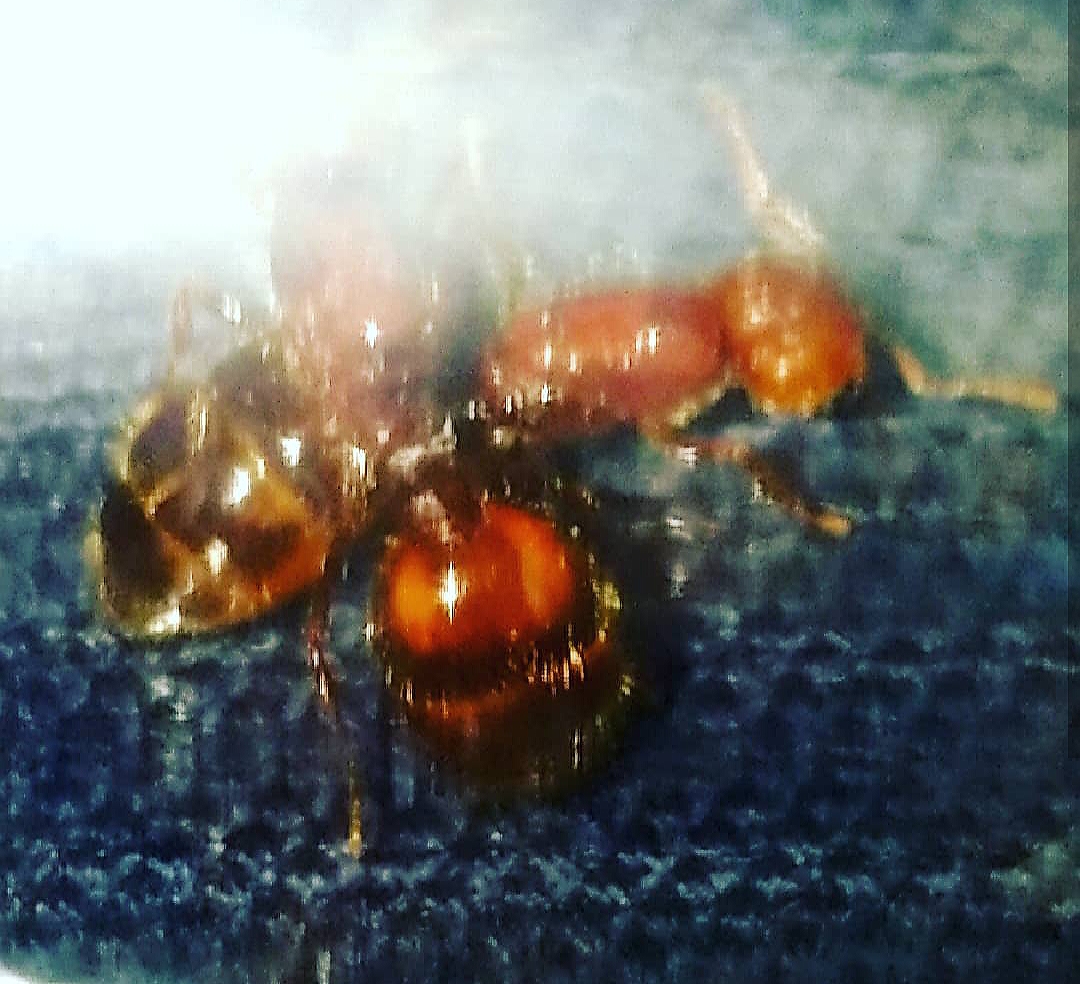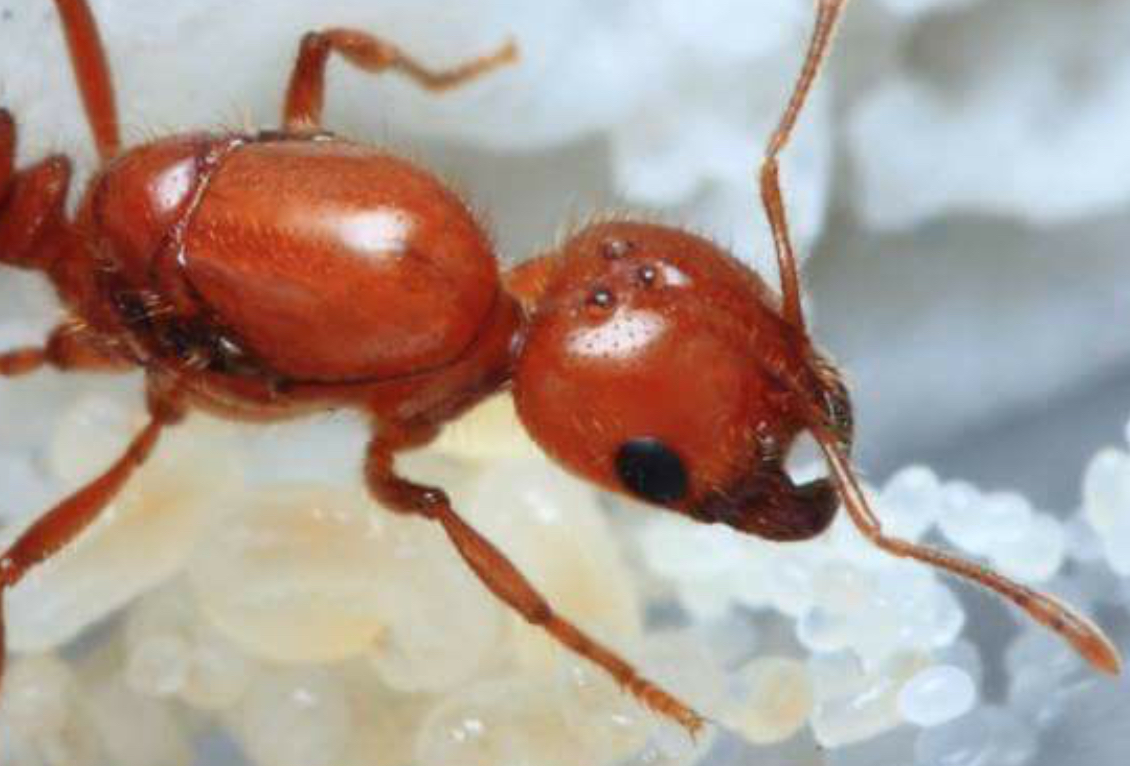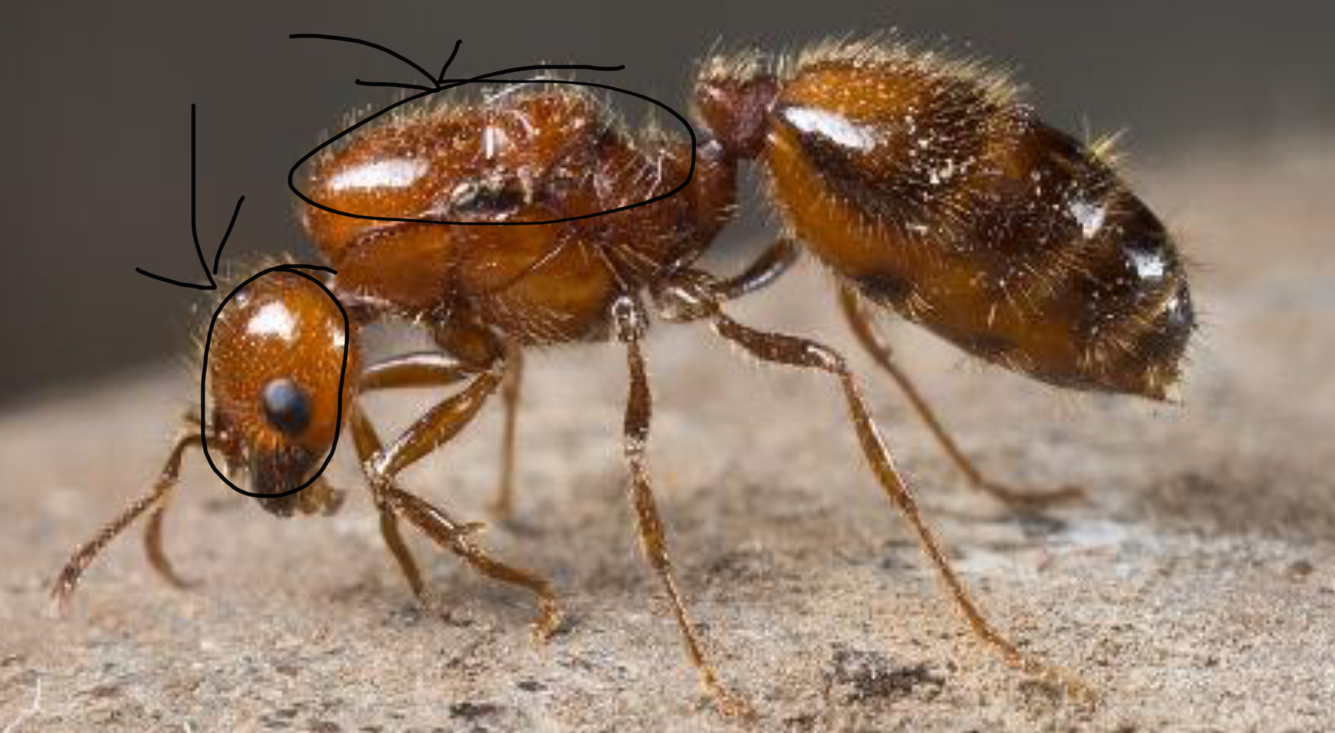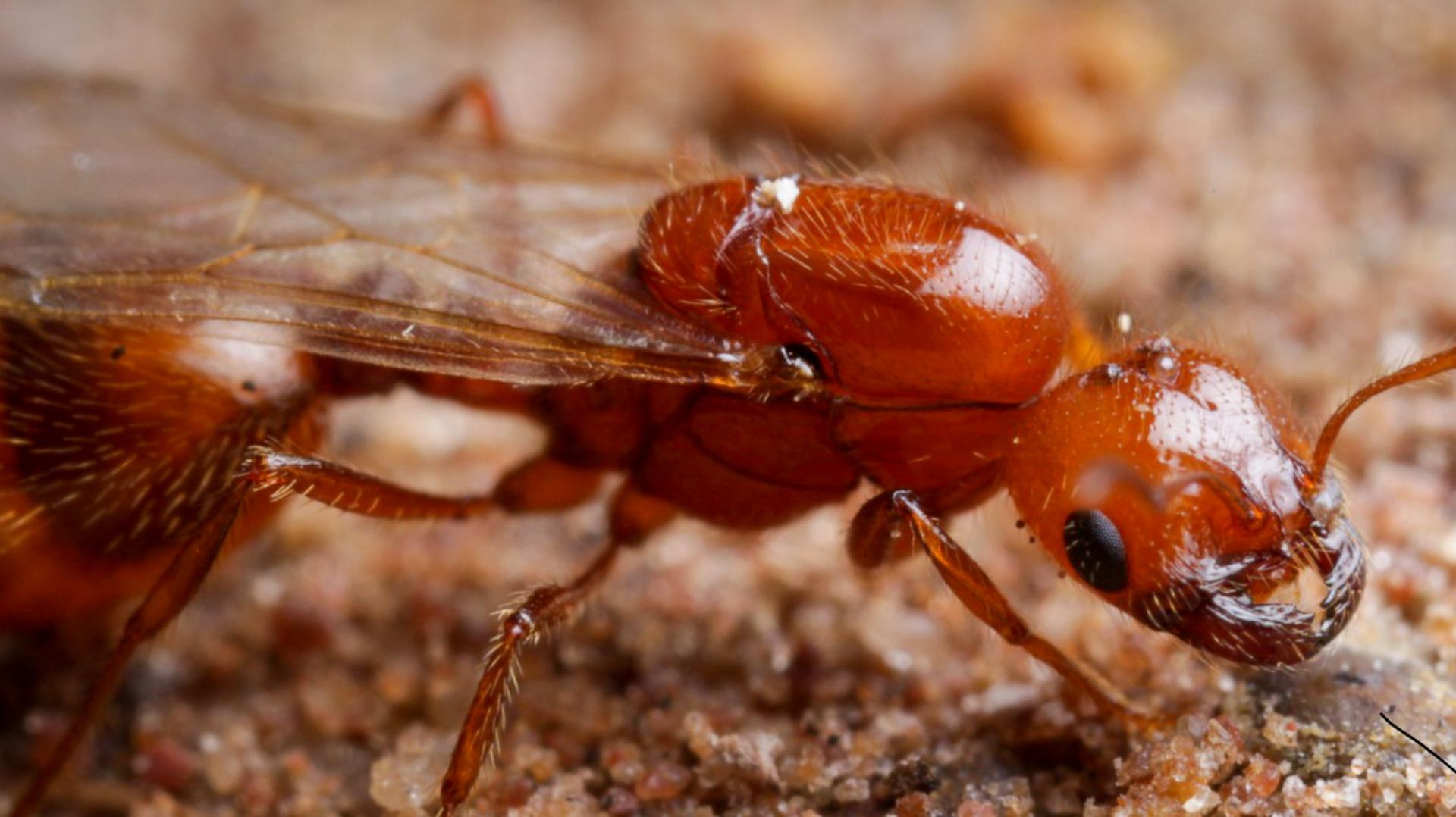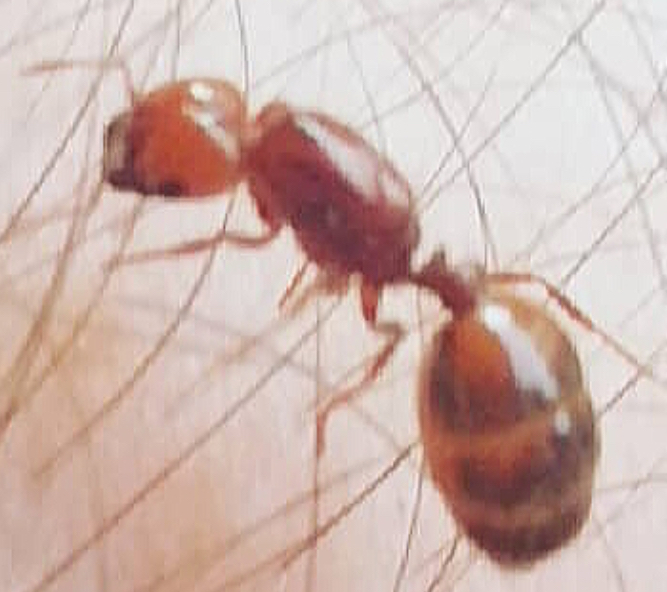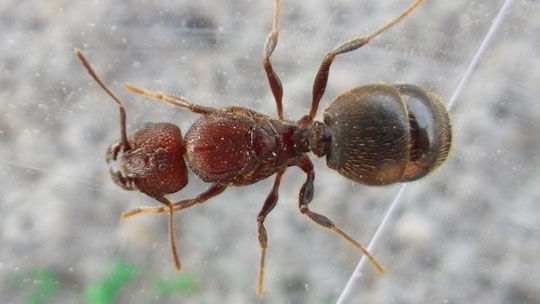- Formiculture.com
- Forums
- Gallery
- Members
- Member Map
- Chat

Species ID Central Florida
Started By
LPN1982
, Aug 15 2020 12:03 AM
12 replies to this topic
#1
 Offline
-
Posted August 15 2020 - 12:03 AM
Offline
-
Posted August 15 2020 - 12:03 AM
I found three queens of this species just right after a rainfall around 10:38pm. I firmly believe they are not Solenopsis invicta. I need an accurate ID if possible. Some of my pictures might not be very good since I do not own a macro-lens.
1. Location of collection: Fruitland Park, FL (Lake County)
2. Date of collection: 9/13/2020
3. Habitat of collection: Grass/Sandy habitat
4. Length: Rough estimate of 7mm-8mm +/-. She moves to fast for exact accuracy.
5. Color, hue, pattern and texture:
Mixture of Red and dark orange (more so orange). Thickish black stripes/blotches upon abdomen.
6. Distinguishing characteristics:
Mandables appear black in color and sickle shaped. Some queens appeared either more red or orange in color than the other. Head and thorax appear thicker/larger than a Solenopsis invicta queen.
7. Distinguishing behavior:
Can be quick moving when disturbed or handled. Seems to tolerate another queen within same test tube setup.
8. Nest description:
These queens were not found in or outside of a nest. Found roaming around the ground roughly at 10:38pm (EST).
9. Nuptial flight time and date:
9/13/2020 10:38pm (EST). Queens were found with wings already shed. No signs of male alates at this time.
1. Location of collection: Fruitland Park, FL (Lake County)
2. Date of collection: 9/13/2020
3. Habitat of collection: Grass/Sandy habitat
4. Length: Rough estimate of 7mm-8mm +/-. She moves to fast for exact accuracy.
5. Color, hue, pattern and texture:
Mixture of Red and dark orange (more so orange). Thickish black stripes/blotches upon abdomen.
6. Distinguishing characteristics:
Mandables appear black in color and sickle shaped. Some queens appeared either more red or orange in color than the other. Head and thorax appear thicker/larger than a Solenopsis invicta queen.
7. Distinguishing behavior:
Can be quick moving when disturbed or handled. Seems to tolerate another queen within same test tube setup.
8. Nest description:
These queens were not found in or outside of a nest. Found roaming around the ground roughly at 10:38pm (EST).
9. Nuptial flight time and date:
9/13/2020 10:38pm (EST). Queens were found with wings already shed. No signs of male alates at this time.
Michael J Borden LPN
Current Keeper Of:
Camponotus floridanus
Camponotus castaneus
Crematogaster ashmeadi
Dorymyrmex bureni
Solenopsis geminata
Current Keeper Of:
Camponotus floridanus
Camponotus castaneus
Crematogaster ashmeadi
Dorymyrmex bureni
Solenopsis geminata
#2
 Offline
-
Posted August 15 2020 - 2:13 AM
Offline
-
Posted August 15 2020 - 2:13 AM
Honestly, I agree with you that these don't look like S. invicta to me. The only other plausible option would be S. geminata, but I won't say that's what they are with 100% confidence. The best way to be certain is checking the number of mandibular teeth. S. invicta will have 2, and S. geminata will have 3.
- AnthonyP163, LPN1982 and Antkid12 like this
#3
 Offline
-
Posted August 15 2020 - 4:11 AM
Offline
-
Posted August 15 2020 - 4:11 AM
Solenopsis geminata.
- LPN1982, Manitobant and NickAnter like this
Ants I have: Tapinoma sessile(2 queen colony). RED MORPH Camponotus neacticus(now has pupae!), Tetramorium immigrans (x3), Aphaenogaster sp, Temnothorax sp, Brachymyrmex sp. possibly infertile ![]() , Ponera pennsylvanica, and Pheidole morrisi!
, Ponera pennsylvanica, and Pheidole morrisi! ![]()
Other insects: Polistes sp. Queen
Ants I need: Pheidole sp., Trachymyrmex sp., Crematogaster cerasi , Dorymyrmex sp. Most wanted: Pheidole morrisii
#4
 Offline
-
Posted August 15 2020 - 5:48 AM
Offline
-
Posted August 15 2020 - 5:48 AM
Solenopsis geminata.
I agree.
- LPN1982 and Antkid12 like this
Hi there! I went on a 6 month or so hiatus, in part due, and in part cause of the death of my colonies.
However, I went back to the Sierras, and restarted my collection, which is now as follows:
Aphaenogaster uinta, Camponotus vicinus, Camponotus modoc, Formica cf. aserva, Formica cf. micropthalma, Formica cf. manni, Formica subpolita, Formica cf. subaenescens, Lasius americanus, Manica invidia, Pogonomyrmex salinus, Pogonomyrmex sp. 1, Solenopsis validiuscula, & Solenopsis sp. 3 (new Sierra variant).
#5
 Offline
-
Posted August 15 2020 - 9:25 AM
Offline
-
Posted August 15 2020 - 9:25 AM
i third this.Solenopsis geminata.
- LPN1982 likes this
My journals:
Polyergus Mexicanus: https://www.formicul...gs/#entry175528
Lasius minutus: https://www.formicul...cs/#entry174811
Lasius latipes: https://www.formicul...gs/#entry206449
General acanthomyops journal: https://www.formicul...yops-with-eggs/
Polyergus Mexicanus: https://www.formicul...gs/#entry175528
Lasius minutus: https://www.formicul...cs/#entry174811
Lasius latipes: https://www.formicul...gs/#entry206449
General acanthomyops journal: https://www.formicul...yops-with-eggs/
#6
 Offline
-
Posted August 15 2020 - 9:39 AM
Offline
-
Posted August 15 2020 - 9:39 AM
Are you sure guys, this looks awfully like a Pheidole sp.
Plus it was found late at night, hasn’t it been documented Pheidole love to fly at night / early morning?
And the blocky head looks like Pheidole too.
I also think the body shape is too large for Solenopsis, quick edit I am looking at some photos of S. geminata and the head shape along with the body size don’t add up to this. I still vote Pheidole.
Another edit, yepp head looks much bigger then some reference photos I’m looking at, take a look at these queens I found online of S. geminata, compare it to the final photo I added of the queen shown in the ID Request at the bottom of my reply.
Plus it was found late at night, hasn’t it been documented Pheidole love to fly at night / early morning?
And the blocky head looks like Pheidole too.
I also think the body shape is too large for Solenopsis, quick edit I am looking at some photos of S. geminata and the head shape along with the body size don’t add up to this. I still vote Pheidole.
Another edit, yepp head looks much bigger then some reference photos I’m looking at, take a look at these queens I found online of S. geminata, compare it to the final photo I added of the queen shown in the ID Request at the bottom of my reply.
Edited by TechAnt, August 15 2020 - 9:50 AM.
My Ants:
(x1) Campontous semitstaceus ~20 workers, 1 Queen
(x1) Camponotus vicinus ~10 workers, 1 Queen (all black variety)
(x1) Tetramorium immigrans ~100 workers, 1 Queen
(x1) Myrmercocystus mexicanus -1 Queen
(x2) Mymercocystus mimcus -1 Queen
(x1) Mymercocystus testaceus ~45 workers, 1 Queen
(x1) Campontous semitstaceus ~20 workers, 1 Queen
(x1) Camponotus vicinus ~10 workers, 1 Queen (all black variety)
(x1) Tetramorium immigrans ~100 workers, 1 Queen
(x1) Myrmercocystus mexicanus -1 Queen
(x2) Mymercocystus mimcus -1 Queen
(x1) Mymercocystus testaceus ~45 workers, 1 Queen
#7
 Offline
-
Posted August 15 2020 - 11:09 AM
Offline
-
Posted August 15 2020 - 11:09 AM
This is not Pheidole. I've noticed you tend to get Pheidole confused with a lot of similar myrmicines, maybe try to read up on the differences. Pheidole are very blocky in the shape of every body part. While the thorax and head on these queens are very large, they do not posses that rectangular squared off shape, instead being rounded and smooth. Another key feature is that NA Pheidole are almost always covered in all sorts of little pits and various forms of sculpturing. I can't think of a single solenopsidini with much sculpturing. Head size is a key feature, but you need to remember not every photo is shot under the same conditions from the same angle. try to visualize the missing parts not shown in the photo within your mind. All the reference photos you provided are shot from the side or diagonally, making the head look more narrow. meanwhile, the photo from the actual ant being IDed is from a mostly top down view. If you compare the first reference photo and the actual ant, you can see the shape is very similar with slight differences, as those 2 photos have the most similar angle.
Heres a reference photo of one of the larger Floridian Pheidole, P. obscurithorax. The many pits and striations are visible as well as the squat, rectangular body.
Anyways, these are Solenopsis geminata. The large bulky head and blunt mandibles designed for milling seeds is evident here.
Edited by ponerinecat, August 15 2020 - 11:10 AM.
- TennesseeAnts, Robert, Antkid12 and 1 other like this
#8
 Offline
-
Posted August 15 2020 - 12:05 PM
Offline
-
Posted August 15 2020 - 12:05 PM
Oh thanks, I will definitely do some reading up on Pheidole spp. compared to its fellow myrmicines, probably on Ant Wiki or something.This is not Pheidole. I've noticed you tend to get Pheidole confused with a lot of similar myrmicines, maybe try to read up on the differences. Pheidole are very blocky in the shape of every body part. While the thorax and head on these queens are very large, they do not posses that rectangular squared off shape, instead being rounded and smooth. Another key feature is that NA Pheidole are almost always covered in all sorts of little pits and various forms of sculpturing. I can't think of a single solenopsidini with much sculpturing. Head size is a key feature, but you need to remember not every photo is shot under the same conditions from the same angle. try to visualize the missing parts not shown in the photo within your mind. All the reference photos you provided are shot from the side or diagonally, making the head look more narrow. meanwhile, the photo from the actual ant being IDed is from a mostly top down view. If you compare the first reference photo and the actual ant, you can see the shape is very similar with slight differences, as those 2 photos have the most similar angle.
Heres a reference photo of one of the larger Floridian Pheidole, P. obscurithorax. The many pits and striations are visible as well as the squat, rectangular body.
QH8RHH2RZH4R0H2RLH8ROLKZCLKZKHIR9LZZPLQZELHZDZ7R6L0ZSHGRHHKZ1L7ZHHSZSHQZLH2RBL.jpg
Anyways, these are Solenopsis geminata. The large bulky head and blunt mandibles designed for milling seeds is evident here.
My Ants:
(x1) Campontous semitstaceus ~20 workers, 1 Queen
(x1) Camponotus vicinus ~10 workers, 1 Queen (all black variety)
(x1) Tetramorium immigrans ~100 workers, 1 Queen
(x1) Myrmercocystus mexicanus -1 Queen
(x2) Mymercocystus mimcus -1 Queen
(x1) Mymercocystus testaceus ~45 workers, 1 Queen
(x1) Campontous semitstaceus ~20 workers, 1 Queen
(x1) Camponotus vicinus ~10 workers, 1 Queen (all black variety)
(x1) Tetramorium immigrans ~100 workers, 1 Queen
(x1) Myrmercocystus mexicanus -1 Queen
(x2) Mymercocystus mimcus -1 Queen
(x1) Mymercocystus testaceus ~45 workers, 1 Queen
#9
 Offline
-
Posted August 17 2020 - 3:53 PM
Offline
-
Posted August 17 2020 - 3:53 PM
A big thank you to everyone's response on the species ID for these queens I caught. I also at one point thought it was a Pheidole species as well. I am glad a majority of people ID'd this as Solenopsis geminata. This is the first time I have ever seen/caught Solenopsis geminata in person.
Michael J Borden LPN
Current Keeper Of:
Camponotus floridanus
Camponotus castaneus
Crematogaster ashmeadi
Dorymyrmex bureni
Solenopsis geminata
Current Keeper Of:
Camponotus floridanus
Camponotus castaneus
Crematogaster ashmeadi
Dorymyrmex bureni
Solenopsis geminata
#10
 Offline
-
Posted August 17 2020 - 3:55 PM
Offline
-
Posted August 17 2020 - 3:55 PM
Be ready, they are going to need a lot of space
- LPN1982 likes this
My Ants:
(x1) Campontous semitstaceus ~20 workers, 1 Queen
(x1) Camponotus vicinus ~10 workers, 1 Queen (all black variety)
(x1) Tetramorium immigrans ~100 workers, 1 Queen
(x1) Myrmercocystus mexicanus -1 Queen
(x2) Mymercocystus mimcus -1 Queen
(x1) Mymercocystus testaceus ~45 workers, 1 Queen
(x1) Campontous semitstaceus ~20 workers, 1 Queen
(x1) Camponotus vicinus ~10 workers, 1 Queen (all black variety)
(x1) Tetramorium immigrans ~100 workers, 1 Queen
(x1) Myrmercocystus mexicanus -1 Queen
(x2) Mymercocystus mimcus -1 Queen
(x1) Mymercocystus testaceus ~45 workers, 1 Queen
#11
 Offline
-
Posted August 17 2020 - 4:01 PM
Offline
-
Posted August 17 2020 - 4:01 PM
I completely understand lol. I had a 2.5yr old (2 queen) Solenopsis invicta colony a few years ago. I ended up selling the whole colony to a friend of mine in order to make room for my growing Camponotus colonies. From what others have told me, geminata has the same care requirements as invicta.Be ready, they are going to need a lot of space
Michael J Borden LPN
Current Keeper Of:
Camponotus floridanus
Camponotus castaneus
Crematogaster ashmeadi
Dorymyrmex bureni
Solenopsis geminata
Current Keeper Of:
Camponotus floridanus
Camponotus castaneus
Crematogaster ashmeadi
Dorymyrmex bureni
Solenopsis geminata
#12
 Offline
-
Posted August 18 2020 - 11:09 AM
Offline
-
Posted August 18 2020 - 11:09 AM
I completely understand lol. I had a 2.5yr old (2 queen) Solenopsis invicta colony a few years ago. I ended up selling the whole colony to a friend of mine in order to make room for my growing Camponotus colonies. From what others have told me, geminata has the same care requirements as invicta.Be ready, they are going to need a lot of space
Unfotunately they do..
My Ants:
(x1) Campontous semitstaceus ~20 workers, 1 Queen
(x1) Camponotus vicinus ~10 workers, 1 Queen (all black variety)
(x1) Tetramorium immigrans ~100 workers, 1 Queen
(x1) Myrmercocystus mexicanus -1 Queen
(x2) Mymercocystus mimcus -1 Queen
(x1) Mymercocystus testaceus ~45 workers, 1 Queen
(x1) Campontous semitstaceus ~20 workers, 1 Queen
(x1) Camponotus vicinus ~10 workers, 1 Queen (all black variety)
(x1) Tetramorium immigrans ~100 workers, 1 Queen
(x1) Myrmercocystus mexicanus -1 Queen
(x2) Mymercocystus mimcus -1 Queen
(x1) Mymercocystus testaceus ~45 workers, 1 Queen
#13
 Offline
-
Posted August 18 2020 - 12:34 PM
Offline
-
Posted August 18 2020 - 12:34 PM
Solenopsis geminata for sure.
My Main Journal | My Neivamyrmex Journal | My Ant Adoption | My YouTube
Join the TennesseeAnts Discord Server! https://discord.gg/JbKwPgs
1 user(s) are reading this topic
0 members, 1 guests, 0 anonymous users



